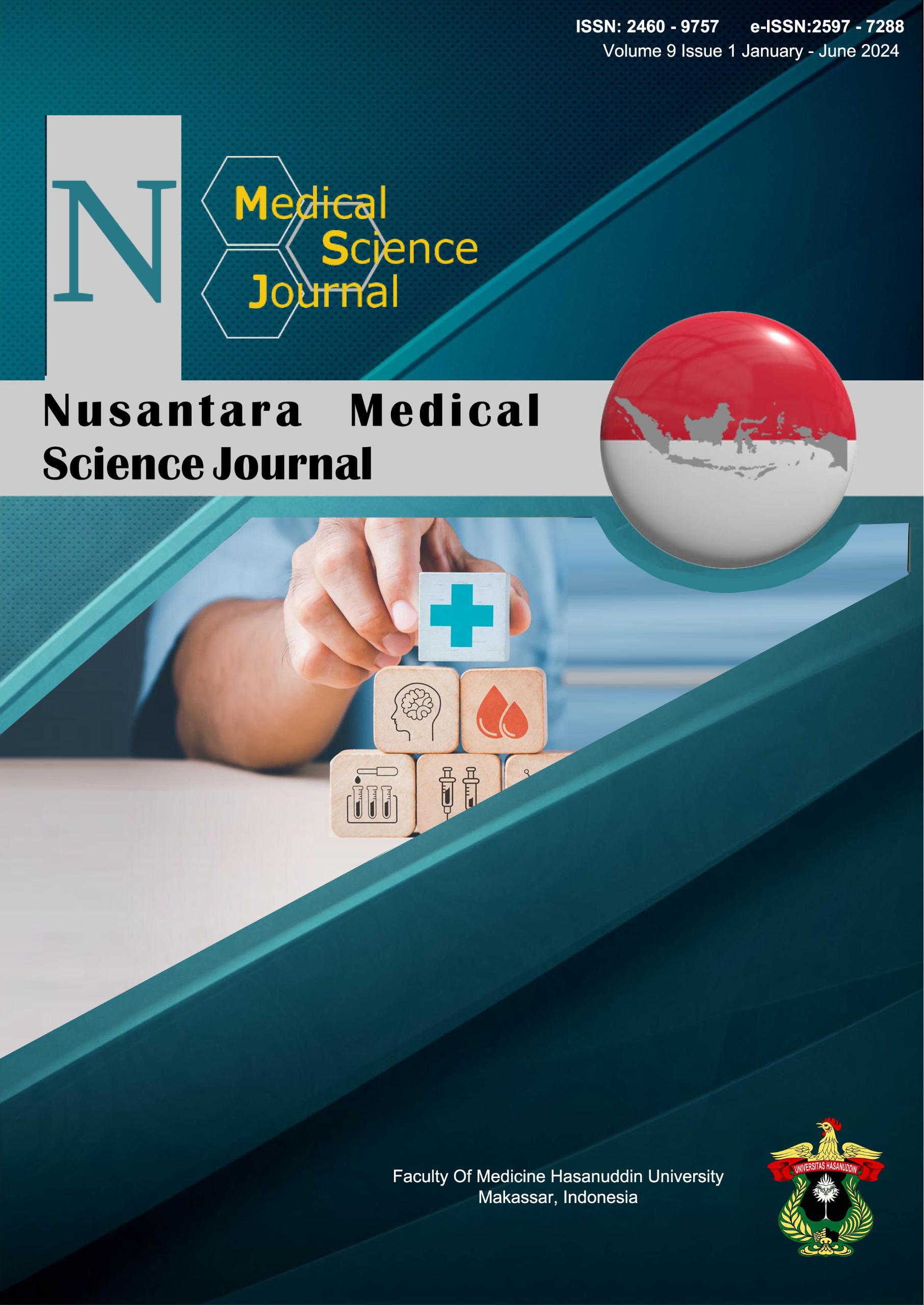Nutritional Therapy in High Output Enterocutaneus Fistula with Ileum Adhesion Grade III-IV : A Case Report
DOI:
https://doi.org/10.20956/nmsj.vi.26614Abstract
Introduction and importance: Enterocutaneus fistula (ECF) is an uncommon connection between the gastrointestinal tract and the skin. Loss of intestinal fluid in ECF patients results in an imbalance of electrolytes. The objectives of nutritional therapy were to fulfill nutrient needs, maintain fluid balance, & promote ECF closure. Presentation of case: A 22-year-old male, was diagnosed with post-adhesiolysis and end colostomy surgery. His oral intake was reduced for one month, and he experienced weight loss. We detected a loss of subcutaneous fat and fistula in the right abdomen region and wasted time on physical examination. Abnormal laboratory findings were leucocytosis, thrombocytosis, imbalance electrolyte, and hypoalbuminemia. Discussion: Nutritional assessment was based on mid-upper arm circumference. Nutritional treatment was provided with a calorie target of 2300 kcal and protein 2g/kg ideal body weight (IBW)/day. On the seventh day of treatment, the patient went through relaparotomy due to high output ECF (2000 ml/d) and ileum adhesion grade 3-4. Following surgery, the patient was on parenteral nutrition for eighteen days. Due to high ECF output, protein intake was increased by 2g/kg IBW/day, and fluid intake was adjusted based on fistula output. The patient received a combination of polymeric formula and whey protein by oral intake and micronutrient supplementation at twice the usual dosage. By the 27th day of treatment, ECF output had decreased to 0 ml/d, and laboratory results showed improvement. Conclusions: Adequate nutrition, fluid, and electrolyte balance through optimal nutritional therapy can improve laboratory values and reduce ECF output in ECF patients
References
Jamie Heimroth, Eric Chen, Erica Sutton. Management Approaches For Enterocutaneous Fistulas. Department of Surgery and Director of Surgical Simulation University of Louisville. 2018. Vol. 8: P326-33.
Vanessa J. Kumpf, Jose Eduardo de Aguilar-Nascimento, Jose Ignacio Diaz-Pizarro Graf, Amber M. Hall, et al. Clinical Guidelines: Nutrition Support of Adult Patients with Enterocutaneous Fistula. Journal of Parenteral and Enteral ASPEN. 2016. Volume 41 Number 1 104–112.
Manal MH Badrasawi, Suzana Shahar, Ismail Sagap. Nutritional management of enterocutaneous fistula: a retrospective study at a Malaysian university medical center. Journal of Multidisciplinary Healthcare 2014:7 365–370.
Cheaito A, Tillou A, Lewis C and Cryer H. Enterocutaneous Fistula: Guidelines for an Evolving Problem. Research Article. 2016. Ann Surg Perioper Care - Volume 1 Issue 2.
Irena Gribovskaja-Rupp, Genevieve B. Melton. Enterocutaneous Fistula: Proven Strategies and Updates. Clin Colon Rectal Surg 2016; 29:130–137.
Suhaib JS. Ahmad, Asad Khan, Ravi Madhotra, Aristomenis K. Exadaktylos, Maria Elena Milioto, George Macfaul, Kamran Rostami. Semi-elemental diet is effective in managing high output ileostomy; a case report. 2019. Gastroenterology and Hepatology from Bed to Bench.
A. Süha Yalçın. Emerging Therapeutic Potential of Whey Proteins and Peptides. Current Pharmaceutical Design, 2006, 12, 1637-1643
Hoffman JR, Falvo MJ. Protein-which is best? J Sport Sci Med 2004; 3: 118-30.
Mertes N, Grimm H, Fu¨ rst P, Stehle P. Safety and efficacy of a new parenteral lipid emulsion (SMOFlipid) in surgical patients: a randomized, double-blind, multicenter study. Ann Nutr Metab 2006;50(3):253–259
Lara J. Williams, Shahram Zolfaghari, and Robin P. Boushey. Complications of Enterocutaneous Fistulas and Their Management. Clin Colon Rectal Surg 2010; 23:209–220. DOI: http://dx.doi.org/10.1055/s-0030-1263062
St-Onge MP, Jones PJ: Greater rise in fat oxidation with medium chain triglyceride consumption relative to long-chain triglyceride is associated with lower initial body weight and greater loss of subcutaneous adipose tissue. Int J Obes Relat Metab Disord 27:1565–1571, 2003
Arenas Villafranca JJ, López-Rodríguez C, Abilés J, Rivera R, Gándara Adán N, Utrilla Navarro P. Protocol for the detection and nutritional management of high-output stomas. Nutr J 2015;9;14:45.
Kiela PR, Ghishan FK. Physiology of Intestinal Absorption and Secretion. Best Pract Res Clin Gastroenterol 2016;30:145-59.
Mountford CG, Manas DM, Thompson NP. A practical approach to the management of high-output stoma. Front Gastroenterol 2014;5:203-7.
Alexander DD, Bylsma LC, Elkayam L, Nguyen DL. Nutritional and health benefits of semi-elemental diets: A comprehensive summary of the literature. World J Gastroenterol Pharmacol Ther 2016;7:306-19.
Adaba F, Vaizey CJ, Warusavitarne J. Management of Intestinal Failure: The High-Output Enterostomy and Enterocutaneous Fistula. Clin Colon Rectal Surg 2017;30:215-22.
Downloads
Published
How to Cite
Issue
Section
License
Copyright (c) 2024 Rima January, Agussalim Bukhari, Nurbaya Syam, Nurpudji Astuti Taslim, Suryani As’ad, Haerani Rasyid, A. Yasmin Syauki

This work is licensed under a Creative Commons Attribution 4.0 International License.









